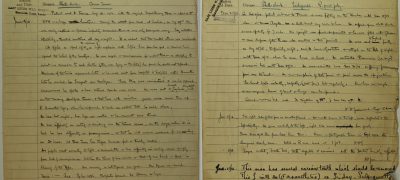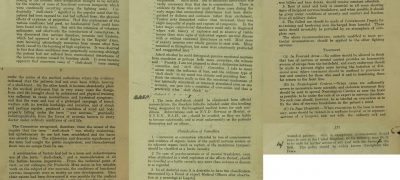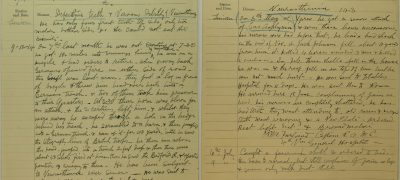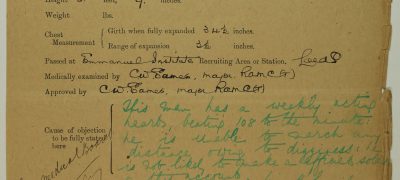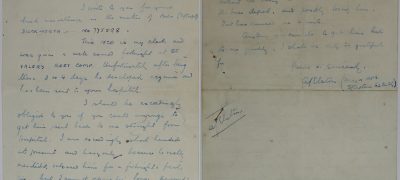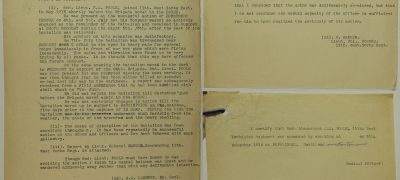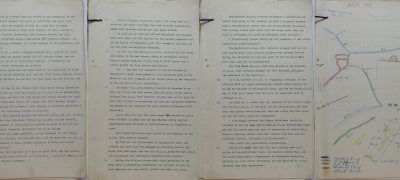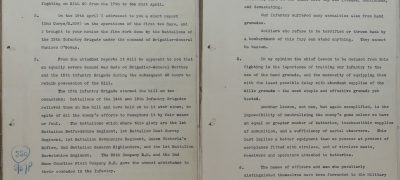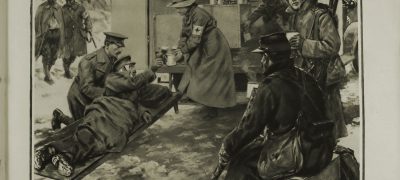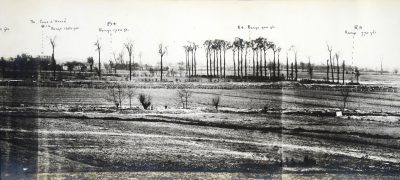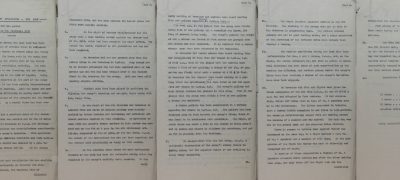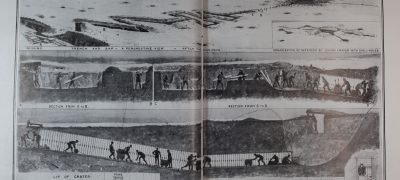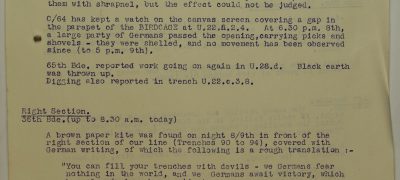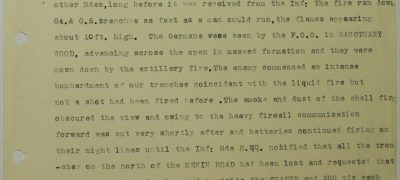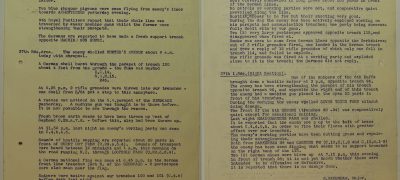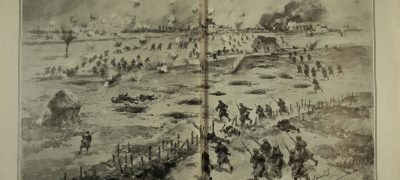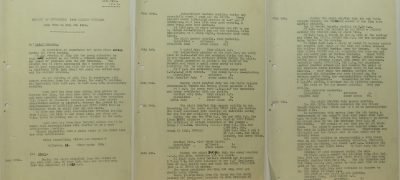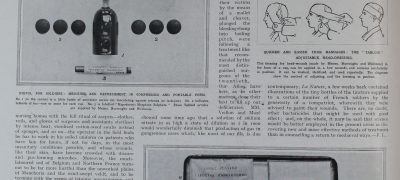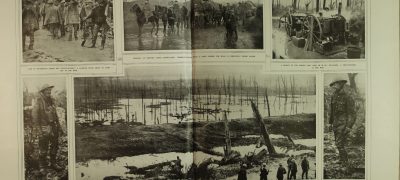
Download documents and transcripts
Teachers' notes
These teachers notes can be downloaded as part of our Teachers Pack PDF. (7.2 MB)
Both these collections of original sources Part 1 and Part 2 can be used to support GCSE thematic modules which cover ‘Medicine through Time to the present day’ and the ‘historical context of the British sector of the Western Front’. Teachers have the flexibility to download and create their own resources from these documents, to develop their pupils’ understanding of how to work with sources and prepare and practice for source based exam questions. Each collection includes a wide range of sources to encourage students to think broadly when exploring these topics.
With each collection we have suggested 5 tasks based on some of the documents. The tasks can be completed individually or in groups.There is a downloadable pdf of questions (0.02 MB) to help working with sources.All documents are provided with transcripts. We hope that exposure to original source material may also foster further document research. The following themes covered by the documents in Part 2 include:
- Treatments for ‘shell shock’, neurasthenia and gas attacks, government reports on ‘shell shock’ and ‘mustard gas’
- The trench system and its organisation and topography.
- Weapons, experience of being under fire, defensive mining, gas masks
- Daily life on the front: from mud to hair cuts
- The attack on Hill 60, south west of Ypres, April 1915
- The experience of ordinary men of their medical treatment and trench warfare gathered from some letters written by those who had worked for Great Western Railway before the war.
- The experience of some of the Women’s Army and Nursing Services on the Western Front
Working with these sources:
It is fundamental when using sources that students get to grips with what they are looking at! What type of source is this? What is being said? How is it being said? For example, if looking at an army medical card, a superficial view response might be that it contains, by its nature, only limited information or only provides answers to generic questions. Encourage students to “look behind the source”. The army records included here infer a huge amount of planning and record keeping and can suggest the scale of a particular problem. Some of information contained may be limited but this suggests that the purpose was to gather statistics for medical authorities/government. Other sources, such as medical case sheets, unit war diaries, reports and pension records can be highly detailed. It is possible to understand a huge amount about how patients were assessed, examined and treated, how their cases progressed and how their treatment continued after the war. Whilst the emphasis of the sources in Part 1 centres on injuries, treatment and medical services, these also provide invaluable information about the nature of trench warfare, its organisation and impact. Part 2 includes sources which focus more specifically on the nature of trench warfare, but also documents relating to the experience of women at the front and further sources covering injuries and treatments during wartime.
When working with the photographs in these collections, students should always consider why has the photograph been taken? Does it show some kind of development or system of organisation? Can you tell if the photograph is posed, or an official war photograph? Remember too, a photograph can be selective in choice of subject or could it have been cropped? Is there an original caption linked to the photograph? Captions can add meaning to a photograph and add a particular message. They are added after the photograph was taken, therefore we must not necessarily take them on face value. It is also useful to know that many soldiers used photography to record their experiences and some carried small Vest Pocket Kodak cameras which were banned after 1915, but many continued to carry them regardless and some such photographs have survived, although examples are not included here. Finally, other soldiers were employed as official photographers during the First World War as well as newspaper photographers.
The big question when working with sources is: how can the evidence provided within the source be considered useful for a particular enquiry question? Therefore, encourage students to consider both the witting and unwitting testimony a source may reveal. Part of this evaluation is to consider if there are any gaps in the evidence or issues of accuracy in authorship. Why would we trust/not trust this source? What other sources might be needed to provide additional information/context? Does the document support other knowledge that you have already for a certain line of enquiry?
Always pay attention to the origin of the source. Ask students to look at the document reference. Do they know what that means? The record series/government department can contribute a whole layer of meaning to the interpretation of a given source. What does the type of record tell you (see below) about the content of the source?
General source guidance questions:
The purpose of these questions is to help students to analyse, evaluate and understand documents in order to develop their own interpretations and conclusions. Teachers may wish to print these out from pdf download and discuss them with the students before they look at the sources.
- What is the date of the source?
- Who wrote/created it?
- Do you know anything about the author?
- What type of source is it? (Letter, report or newspaper, war diary, pension record, medical record, map, diagram, photograph.)
- What is the source saying/showing?
- Check the meaning of any words you are unsure about.
- How useful is this information, does it support what you know already?
- What can you infer (information which is not directly stated)
- What type of enquiry would be this record be useful for?
- Does the document show the writer’s opinions/values?
- Are there any clues about the intended audience for the document?
- Why was the document created?
- Does it have any limitations or gaps?
- Does it link to other sources in this group?
- Does it share the same ideas, attitudes and arguments?
- How would you explain any differences between these documents?
Connections to the Curriculum
- AQA GCSE History: Conflict and tension: the First World War, 1894–1918 The Western Front: military tactics and technology, including trench warfare
- Edexcel GCSE History: Medicine in Britain, c1250 present and The British sector of the Western Front, 1914 18.
- OCR GCSE History: War and British Society c.790 to c.2010: The First World War: the beginnings of ‘total war’, including the impact on people’s lives.
- Edexcel GCE ‘A’ level History: British Experience of Warfare c1760-1918: Trench warfare on the Western Front 1914-1918
Tasks
Getting started
Aim: to expose pupils to a range of sources available for research into trench warfare, injuries and treatments on the Western Front. Start with a survey of the type of sources in this collection.
- Ask the pupils to identify and list as many different types of sources they can find in the collection, e.g. medical army forms, photographs, medical reports, war diaries, pension records, newspaper articles etc. It is important to discuss why it is important to explore a wide range of sources on this topic. To just focus on army medical forms for finding out about medical treatment or injury is too narrow- other record series can expand an enquiry as this task demonstrates.
- Are there any potential source types missing in this collection? [Oral testimony, film]
- Break the class up into groups and get students to feedback/or annotate at a white board which sources could be relevant to particular enquiry questions
- Spend time on exploring what the document references stand for. Knowing which government department lies behind a particular record can be helpful and add context: For example:
MH 106 records come from the Ministry of Health. These medical records were brought together by the Medical Research Committee and the British Museum during and after First World War, for use in statistical studies of the treatment for injuries and diseases contracted by British troops. The records include admission and discharge registers to selected Field Ambulance units, Casualty Clearing Stations, Base and Home Hospitals and hospital ships. There are medical case sheets, detailing diseases, different injuries and treatments prescribed and hospital of admission in the U.K, medical cards for individuals noting the name of the soldier, nurse or civilian admitted; unit; squadron, battery or company; regimental number; rank; age; years of service with dates of discharge, transfer or death.
WO records come from the War Office These include the unit war diaries of the British Army in the First World War series WO 95: https://discovery.nationalarchives.gov.uk/details/r/C14303. The diaries are not personal diaries, they may contain details of troop movements, daily routine, intelligence reports, maps or trench maps for example. A few contain details about awards of the Military Medal and the Meritorious Service Medal. The war diaries cover work carried out by the battalion and can provide an insight into the conditions and experience of men in the trenches during the war. Different parts of the collection cover units serving in different theatres e.g. for France and Flanders: WO 95/1-3154, WO 95/3911-4193 and WO 95/5500.
PIN records come from Ministry of Pensions and National Insurance and the records concern war disability pension awards. These cases cover all types of disability pensions awarded after the First World War, and include files for serving men and officers, army, navy and air force, widows and dependants, and nurses. The records reflect the impact of war on people. Deafness, as a cause for disability is highlighted as a result of trench warfare and as an effect of traumatic shell-shock. Again serious cases of trench foot have been the subject of disability awards. The PIN records can show us changes in medical technology. For example records (PIN 38/450) in the series reveal the growth of companies making hearing aids to help those whose hearing was damaged by the sound of heavy explosions and guns. Again the Disablement Services Service section within PIN 38 specifically deals with the supply of artificial limbs and appliances.
ZPER records included in both these themed collections are very useful sources for this topic. They include articles and photographs and drawings from the Illustrated London News. It is important for students to consider the tone and voice of these articles and explore why particular photographs and illustrations have been selected for publication.
CAB 23/2 Cabinet Papers are a useful source for this topic and are available on our Cabinet Papers website:
https://www.nationalarchives.gov.uk/cabinetpapers/themes/total-war.htm
Students can access a series of secret cabinet conclusions (records of cabinet meetings) which were transferred to The National Archives after 30 years and released to the public. These documents cover the Western Front in First World War including: Battles of Somme, Arras, Third Battle of Ypres, Cambrai, German Offensives, Battle of Amiens and the final offensive. There is also related content on the website for these documents.
Nurses’ records
Records relating to individual nurses can be found in WO399, which is arranged by individual name. This series is not entirely complete but represents the largest surviving collection of records for the QAIMNS and the TFNS. There are also some surviving records for soldiers and officers in WO 363 and WO 364 respectively. Individual files may make reference to medical treatment.
Hospital Records
Records relating to individual hospitals at home may be found in the collections of local authority archives.
Task 2: Take two sources!
Trench map (WO 297/6648) and trench photographs with article from the Illustrated London News entitled: ‘Natural hardships: The campaign against “General Mud” on the British Western Front’, 16 December 1916, (ZPER 34/148).
- What are the key differences between the trench map and the newspaper photographic article in what they reveal about the trench organisation and construction?
- What are the advantages and disadvantages of each type of source?
- Discuss which source would be most useful for enquiring into the organisation and working of the trench system?
Extension
Now take a look at a third source, ‘Drawing of a trench siege’, an artist’s impression from a war artist for the Illustrated London News, 2 January 1915, (ZPER 34/146)
What does this source reveal about the organisation of the trenches?
- Is its value limited because it is an artist’s impression? Explain your reasons.
- Does the picture support the other two sources?
- Does it provide any additional information useful for an enquiry into the organisation and function of the trench system?
Teachers could repeat this task selecting other pairs of documents based on different enquiry questions based on the trenches for their students and/or set the students the task of devising their own enquiry questions after considering the sources available here.
Task 3: Which sources from this collection would be useful for the following enquiry questions? Make sure give reasons for your choice.
- Either: What were the effects of gas attacks on the Western Front? How were gas cases treated?
- Or: What was ‘shell shock’ and how was it treated? Have attitudes towards treatment of PTSD changed today?
Task 4: How valuable for historians is personal testimony in understanding the injuries and treatments used for soldiers on the Western Front?
Refer to these letters (RAIL 252/515): ‘I look a pretty picture’; ‘It is a warm shop; ‘Beastly complaint’; ‘Big dose of gas shells’; ‘They were mostly mere boys’; and MH 106/2154: ‘An officer’s letter’ from this collection.
Task 5
What role was played by the women’s services on the Western front? Refer to these sources: WO 95/85: ‘Women’s army in France’; WO 162/36: ‘Role of the VADS’; MH106/2208: ‘A woman’s war experience’; HS 7/7: ‘First Aid Nursing Yeomanry’; WO 399/3760: ‘Nurse killed in action’; WO 399/15442: ‘Nurse mentioned in dispatches’.
Finally, track down a soldier!
In order to encourage students to engage with original documents and appreciate the range of source material which can be used to find out about medicine, injury and treatment on the Western Front, a class/individual students could carry out their own research into the life of a soldier from enlistment to service, injury, discharge, death and pension record.
The Long Long trial website gives an excellent guide on how to trace a soldier: https://www.longlongtrail.co.uk/soldiers/how-to-research-a-soldier/. Hospital admissions and discharge records for your soldier, MH106 are not digitised yet (apart some examples here in this collection) so you would have to visit The National Archives.
- If you want to find an example of a person in a medical unit start by looking at service records as these can contain details of medical units which treated a wounded or sick soldiers: https://www.nationalarchives.gov.uk/help-with-your-research/research-guides/british-army-medal-index-cards-1914-1920/
- The Division that a soldier served in can also help identify the Field Ambulance units that were attached to that division.
- ‘Location of Medical Units’ WO 95/5494 details the medical units and hospitals in order by hospital type.
- First World War unit war diaries. The National Archives has published the unit war diaries for the cavalry divisions and a number of infantry divisions online (catalogue references WO 95/1096 to WO 95/1226, and WO 95/1227 to WO 95/3154 inclusive). They cover the entire period of the units’ involvement in the war.
- This guide will help you find disability and dependents’ pension records for British military personnel, merchant seamen and nurses who served in the First World War https://www.nationalarchives.gov.uk/help-with-your-research/research-guides/disability-dependents-pensions-first-world-war/
Commonwealth War Graves Commission https://www.cwgc.org/
Members of British Army who died during the First World War, are included in commemorative records of the Commonwealth War Graves Commission (CWGC). The original burial and cemetery documents have been digitised and published on the Commission’s website and can be searched. CWGC marks end of First World War Centenary with 120 personal stories to represent the 120,000 lives lost from Amiens to Armistice. Using the battalion information provided within these stories, students could research for the war diary for that person’s unit.
Introduction
The records in this collection include other war diary extracts which evidence the nature of trench warfare. For example, some of the diaries here describe ‘defensive mining’ including the attack on Hill 60, south west of Ypres in April 1915, types of weapons used and equipment, including P.H. helmets and box respirators, and the first use of ‘liquid fire’ at Hooge. These sources give important context to the nature of the injuries and diseases experienced by those who fought on the Western Front. Again, some of the war diary extracts shown here give information about different types of trenches and their organisation and how trenches were supplied, wired, repaired and rebuilt. Two trench maps also help provide more information about trench system. Photographic evidence, including a ‘trench panorama’ available here, reveals the landscape and the conditions that soldiers were forced to experience as well as the environment that the medical services had to operate within when treating and caring for the sick and wounded.
There are also documents relating to other illnesses on the Western Front, including shellshock and a War Office report from a committee of ‘Enquiry into the Causation and Prevention of the condition’. Some medical case sheets in this collection refer to another condition, neurasthenia, which many ‘shell shock’ patients showed symptoms of as well. Probably over 250,000 men suffered from ‘shell shock’ as result of the First World War. The term was coined in 1915 by medical officer Charles Myers. At the time it was believed to result from a physical injury to the nervous system during a heavy bombardment or shell attack, later it became evident that men who had not been exposed directly to the front line were just as traumatised. This was a new illness that had never been seen before on this scale. In addition, there are sources relating to the nature of gas warfare including government reports on ‘mustard gas’ and sources on types of mask and how they worked. A chemical Warfare document described treatment of severe gas patient cases.
The experience of some of the Women’s Army and Nursing Services on the Western Front are included in this collection. These sources give an insight into their work and the difficult circumstances in which they worked. The Casualty Clearing Stations were managed by the Royal Army Medical Corps (RAMC) and staffed by the Queen Alexandra’s Imperial Military Nursing Service (QAIMNS), sometimes supported by nurses from the Territorial Forces Nursing Service (TFNS) and members of the Voluntary Aids Detachment (VAD) and the First Aid Nursing Yeomanry (FANY). This collection also includes a Foreign Office source statement on the execution of Edith Cavell.
Finally, a small selection, taken from a wider collection of digitised original letters (also available on the National Archives Education website) written by those who had worked for Great Western Railway before the war, provides a specific window into the experience of ordinary men of their injuries, medical treatment and trench warfare.
External links
Web links related to nursing services
A useful website providing detail all nursing services and VADS https://www.scarletfinders.co.uk/
A nursing sister on the Western front: https://www.thehistorypress.co.uk/articles/a-nursing-sister-on-the-western-front/
A day in the life of a field nurse: https://www.thehistorypress.co.uk/articles/what-was-a-typical-day-like-for-first-world-war-field-nurses/
Film sources
St John in the First World War – with a particularly good film telling the story of a fictional VAD nurse: https://museumstjohn.org.uk/research/projects/st-john-first-world-war/
Students could consider British Pathe film sources as interpretations of the First World War in relation to these documents on trenches, injuries and medical treatment: https://www.britishpathe.com/
Oral testimony online
Students can explore some of the oral testimonies and eyewitness accounts available from the Imperial War Museum Sound Collections alongside the written and photographic sources available in this collection: https://www.iwm.org.uk/collections/search?
Poetry
First World War Digital Poetry Archive: https://www.oucs.ox.ac.uk/ww1lit/
Other useful links
The National Army Museum’s Birth of Plastic Surgery resource: https://www.nam.ac.uk/explore/birth-plastic-surgery/
Back to top
